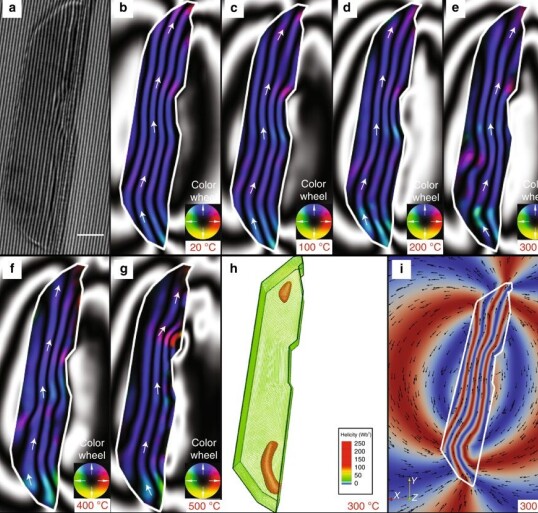Overview
 Geomagnetic Field Variation
Geomagnetic Field Variation
The Earth's magnetic is constantly changing. To understand variations on long geological timescales, we need to examine the magnetic signal recorded by rocks during their formation. Extracting directional magnetic recording from rocks is relatively straightforward, but extracting the intensity of the ancient field is much more problematic. Reliable intensity data is required if we are to construct accurate geomagnetic field models and understand the long-term behaviour of the fluid motions deep within the earth where the field originates. With several colleagues, I am working on several new methods of determining accurate ancient geomagnetic field intensity (palaeointensity) determination.
Magnetotactic bacteria
Magnetotactic bacteria contain chains of magnetic crystals (usually magnetite), which are termed magnetosomes. The bacteria use these chains of magnetosomes as magnetic compasses to help navigate towards their optimal environment, which is in the oxic-anoxic transition zone. This affect is termed magnetotaxis. To maximize magnetotaxis the magnetosomes should be large to increase the magnetic signal, but not so large that the magnetization in the individual magnetosomes becomes non-uniform and less efficient. With Wyn Williams at the University of Edinburgh, we have used numerical micromagnetic models to determine optimal grain and spatial geometries for chains of magnetotactic bacteria.
Unravelling complex magnetic signals
The magnetic signature of most natural magnetic materials is highly complex. To interpret such signals in geological or environmental terms requires a good understanding of fundamental magnetic processes, such as magnetic hysteresis, and a knowledge of chemical effects such as diagenesis, which can strongly alter mineralogy. With a number of colleagues, I examine a range of fundamental mineral magnetic properties and develop new methods of extracting meaningful information from rocks. We employ several of approaches from examining well-characterized rocks, to synthesizing magnetic mineralss to constructing numerical models.
Evolution of Volcanic Processes
Violent pyroclastic volcanic eruptions such as the famous "Pompeii" eruption of Mt. Vesuvius in 79 AD, can be highly destructive . To assess the risk for the today's local inhabitants it is important to have a knowledge of the historical behaviour of such geohazards. Pyroclastic density currents generated during eruptions can move at high speeds in excess of 100 km per hour, but more importantly can vary in temperature from ambient up to 1000 C. Obviously the temperature strongly affects the danger to local inhabitants and livestock. The only method of estimating the emplacement temperature of past pyroclastic deposits, is through examination of the magnetic signature acquired by lithic clasts during the eruption. With colleagues, I employ palaeomagnetic techniques to study the evolution of volcanic processes
Research Staff
Research Student Supervision
Abdulkarim,M, Using mineral magnetics and petroleum systems modelling to calibrate hydrocarbon migration: A case study from the UK Central North Sea (2018-2022)
Abubakar,R, Mapping petroleum migration pathways using magnetics, geochemistry and seismic interpretation. Case study: Wessex Basin, southern England, UK (2011-2016)
Archibald,E, Glacial history of the West Antarctic Ice Sheet: An isotopic geochemical and palaeomagnetic inventory of West Antarctic rock material (2022- )
Badejo,SA, Application of magnetic techniques to lateral hydrocarbon migration - Lower Tertiary reservoir systems, UK North Sea (2015 -2019)
Baker,E, Determining ancient field intensities from chemical remanant magnetisations in rocks and meteorites (2019 -2024)
Barron,L, How do magnetic intergrowths in nanoscale intergrowths affect palaeomagnetic interpretations? (2006-2011) (University of Edinburgh)
Berndt,T, Viscous Remanent Magetization (VRM) Dating of Cataclysmic Floods and Palaeotsumanis (2013-2016)
Chang,L, Determining the fundamental properties of greigite (Fe3S4). (2005-2009) (University of Southampton)
Dodd,S, Constraining the timing and duration of Large Igneous Province Volcanism: magnetostratigraphic constraints from the Etendeka traps, Namibia (2011-2014)
Emmerton,S, A new magnetic mineral based technique for detecting hydrocarbons. (2009-2012)
Kugabalan,B, Determining ancient field intensities from shock remanent magnetisations in rocks and meteorites (2022- )
Marsh,J, Testing The Core-Mantle-Boundary & Large Igneous Province Hypothesis: A Full-Vector Palaeomagnetic Study Of The North Atlantic Igneous Province (2022- )
Nagy,L, Parallelisation of Micromagnetic Simulations (2011-2014) (University of Edinburgh)
North,T, Impacts as a palaeomagnetic recording mechanism in meteorites (2018-2023)
Osamor,J, Understanding magnetic enhancement in hydrocarbon reservoirs (2017-2021)
Paterson,GA, A new approach to determining the ancient geomagnetic field intensity using pyroclastic deposits. (2005-2009) (University of Southampton)
Penny,C, Nanoparticles in meterorites: the contribution of surfaces to the magnetic curie temperature and magnetic recording fidelity (2015-2019)
Perkins,J, Hydrocarbon so:urce and migration pathway identification through basin & petroleum systems modelling and mineral magnetism: a case study on the Beatrice Field, Inner Moray Firth, UK North Sea (2018-2022)
Qi,L, Understanding How Serpentinization Affects Marine Magnetic Anomalies (2021 - )
Shah,J, Understanding the origin of meteoritic magentism: Implications for the proto-planetary disk formation (2013 - 2017)
Supakulopas,R, Deviations from the Geocentric Axial Dipole hypothesis: High-latitude study of the palaeomagnetic field (2014-2018)
Tshwenyego,K, Ancient geomagnetic field intensities in the Proterozoic (2018 - ) (University of Botswana)
Turney,J, Magnetic enhancements at past and present oil-water contacts in hydrocarbon reservoirs: Wytch Farm oilfield, Wessex Basin, UK (2020- )
Valdez Grijalva,M, A numerical investigation of hydrocarbon magnetic signatures (2014-2018)


 Geomagnetic Field Variation
Geomagnetic Field Variation